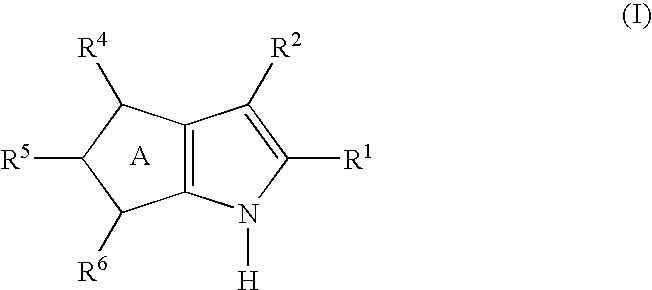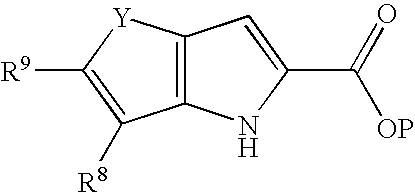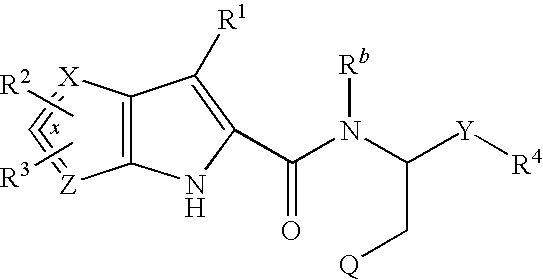Glucokinase-activating fused heterocyclic compounds and methods of treating diabetes and obesity
a technology of glucokinase activation and heterocyclic compounds, applied in the field of glucokinase activation fused heterocyclic compounds and methods of treating diabetes and obesity, can solve the problems of impaired glucose tolerance and diabetes, insulin secretion failure, and lower liver glucose metabolism, and achieve the effect of superior glucokinase activation
- Summary
- Abstract
- Description
- Claims
- Application Information
AI Technical Summary
Benefits of technology
Problems solved by technology
Method used
Image
Examples
reference example 1
1-benzyl-2-methyl-1H-imidazole-4-carbaldehyde
[0585]
[0586]To a solution of 2-methyl-1H-imidazole-4-carbaldehyde (5.50 g) in N,N-dimethylformamide (100 mL) was slowly added sodium hydride (60%, oily, 2.4 g) at 0° C., and the mixture was stirred at room temperature for 30 min. Benzylbromide (7.1 mL) was slowly added to the reaction mixture, and the mixture was stirred overnight at room temperature. Water was added to the reaction mixture, and the mixture was extracted with ethyl acetate. The ethyl acetate layer was washed with saturated brine, dried (MgSO4) and concentrated. The residue was subjected to silica gel column chromatography to give 1-benzyl-2-methyl-1H-imidazole-4-carbaldehyde (3.8 g, yield 38%) as colorless crystals from a fraction eluted with ethyl acetate-hexane (1:1, volume ratio). melting point 61° C.
reference example 2
4-bromo-5-methylthiophene-2-carbaldehyde
[0587]
[0588]To a solution of 5-methylthiophene-2-carbaldehyde (50.0 g) in acetic acid (400 mL) was added dropwise a solution of bromine (25 mL) in acetic acid (200 mL) at room temperature over 6 hr. After the dropwise addition, the reaction mixture was stirred overnight, neutralized with saturated aqueous sodium hydrogen carbonate solution, and extracted with ethyl acetate. The ethyl acetate layer was washed with saturated brine, dried (MgSO4) and concentrated. The obtained residue was dissolved in toluene (50 mL), and the mixture was stirred at 110° C. for 2 hr and concentrated. The residue was subjected to silica gel column chromatography, eluted with ethyl acetate-hexane (1:5, volume ratio) and concentrated to give 4-bromo-5-methylthiophene-2-carbaldehyde (40.0 g, yield 50%) as yellow crystals. melting point 60° C.
reference example 3
2-(4-bromo-5-methyl-2-thienyl)-1,3-dioxolane
[0589]
[0590]A mixture of 4-bromo-5-methylthiophene-2-carbaldehyde (6.0 g), ethylene glycol (100 mL), p-toluenesulfonic acid (2 mL) and toluene (100 mL) was heated under reflux for 5 hr with a Dean-Stark trap. The reaction mixture was washed with water and saturated brine, and the obtained organic layer was dried (MgSO4) and concentrated. The residue was subjected to silica gel column chromatography to give 2-(4-bromo-5-methyl-2-thienyl)-1,3-dioxolane (6.96 g, yield 93%) as a yellow oil from a fraction eluted with ethyl acetate-hexane (1:5, volume ratio).
[0591]1H-NMR (CDCl3) δ: 2.37 (3H, s), 3.97-4.18 (4H, m), 5.99 (1H, s), 6.96 (1H, s).
PUM
| Property | Measurement | Unit |
|---|---|---|
| concentration | aaaaa | aaaaa |
| concentration | aaaaa | aaaaa |
| concentration | aaaaa | aaaaa |
Abstract
Description
Claims
Application Information
 Login to View More
Login to View More - R&D
- Intellectual Property
- Life Sciences
- Materials
- Tech Scout
- Unparalleled Data Quality
- Higher Quality Content
- 60% Fewer Hallucinations
Browse by: Latest US Patents, China's latest patents, Technical Efficacy Thesaurus, Application Domain, Technology Topic, Popular Technical Reports.
© 2025 PatSnap. All rights reserved.Legal|Privacy policy|Modern Slavery Act Transparency Statement|Sitemap|About US| Contact US: help@patsnap.com



